The U.S. spatial genomics & transcriptomics market size was estimated at USD 97.53 million in 2023 and it is expected to surpass around USD 323.25 million by 2033, poised to grow at a CAGR of 12.73% from 2024 to 2033.
Spatial genomics and transcriptomics are emerging fields within genomics that enable researchers to study gene expression and spatial organization within tissues with unprecedented detail. In the United States, these technologies are poised to revolutionize biomedical research and clinical diagnostics, offering insights into cellular interactions, disease mechanisms, and personalized medicine.

Key Highlights:
- Consumables Rule the Roost: Consumables dominated the market in 2023, accounting for a whopping 54% revenue share. However, software is poised for significant growth, with the highest projected CAGR from 2024 to 2033.
- Spatial Transcriptomics Takes the Lead: Spatial transcriptomics reigned supreme in 2023, capturing a massive 80% market share.
- Translational Research Takes Charge: Translational research labs were the primary users in 2023, leading the market with a 61% share.
- Academia on the Rise: The future looks bright for academic institutions, which are expected to experience the fastest growth rate (CAGR of 12.04%) from 2024 to 2033.
Get a Sample@ https://www.visionresearchreports.com/report/sample/41353
Drivers of the U.S. Spatial Genomics & Transcriptomics Market
- Advancements in Technology: Continuous innovations in sequencing and imaging technologies enable high-resolution spatial mapping of gene expression, enhancing understanding of tissue architecture.
- Rising Demand for Precision Medicine: Growing emphasis on personalized medicine drives the need for detailed spatial analysis of gene expression patterns to tailor treatments based on individual patient characteristics.
- Application in Oncology Research: Spatial genomics facilitates the study of tumor heterogeneity and microenvironment interactions, aiding in the development of targeted therapies and biomarker discovery.
- Government Funding and Initiatives: Supportive policies, grants, and funding from government agencies like NIH accelerate research in spatial genomics and transcriptomics.
- Collaborative Research Efforts: Increasing collaborations between academia, biotechnology firms, and healthcare providers foster innovation and application development in spatial genomics.
Challenges Facing the Market
- Complex Data Analysis: Handling large-scale spatial datasets requires advanced computational methods and bioinformatics expertise, posing challenges in data interpretation and integration.
- Cost Constraints: High costs associated with sequencing technologies and spatial imaging instruments limit widespread adoption, particularly in smaller research institutions and clinics.
- Standardization and Reproducibility: Ensuring consistency and reproducibility of spatial genomics data across different platforms and laboratories remains a challenge.
- Regulatory and Ethical Considerations: Regulatory pathways for clinical implementation of spatial genomics technologies require clear guidelines due to novel data outputs and potential ethical implications.
- Educational and Training Needs: Addressing the gap in skilled professionals proficient in spatial genomics data analysis and interpretation is essential for market growth.
Trends Shaping the Market
- Integration with Single-Cell Analysis: Combining spatial genomics with single-cell sequencing technologies enables comprehensive characterization of cellular phenotypes and spatial interactions.
- Advancements in Imaging Modalities: Development of advanced imaging techniques such as multiplexed fluorescence in situ hybridization (FISH) and spatial transcriptomics expands capabilities in spatial analysis.
- Expansion Beyond Oncology: Applications in neuroscience, developmental biology, immunology, and infectious diseases broaden the market scope of spatial genomics and transcriptomics.
- Automation and Robotics: Integration of automation and robotics in sample preparation and imaging workflows enhances throughput and reproducibility in spatial genomics assays.
- Commercialization and Market Entry: Increasing investments by biotechnology companies and startups in developing user-friendly platforms and kits for spatial analysis drive market expansion.
Segmental Insights
- Research Applications: Dominated by academic and research institutions conducting basic and translational research in oncology, neuroscience, and developmental biology.
- Clinical Diagnostics: Emerging segment exploring potential applications in cancer diagnostics, patient stratification, and monitoring treatment response.
- Pharmaceutical and Biotechnology Industries: Utilized for drug discovery and development, biomarker identification, and preclinical research studies.
- Others: Includes applications in agriculture, environmental sciences, and veterinary medicine, expanding the market footprint of spatial genomics and transcriptomics.
Read More@ https://www.heathcareinsights.com/u-s-nanomedicine-market/
U.S. Spatial Genomics & Transcriptomics Market Key Companies
- NanoString Technologies, Inc.
- S2 Genomics, Inc.
- Illumina, Inc.
- Dovetail Genomics
- 10x Genomics
- Seven Bridges Genomics
- Readcoor, Inc
- Bio-Techne
- Advanced Cell Diagnostics (ACD)
Recent Developments
- In March 2024, 10x Genomics, Inc. unveiled its groundbreaking Visium HD Spatial Gene Expression product, enabling researchers to analyze the entire transcriptome from FFPE tissue sections with single-cell resolution. This innovative assay offers a comprehensive understanding of gene expression patterns within tissues, providing researchers with a potent tool to investigate cellular biology with unprecedented detail.
- Around the same time, biomedical engineers at Johns Hopkins introduced an inventive computational technique named STalign. This method accurately aligns spatial transcriptomics (ST) data across different samples, resolutions, and technologies, empowering researchers to delve deeper into cellular biology. STalign enhances researchers’ ability to effectively compare spatial single-cell data, facilitating comprehensive insights into cellular organization and function.
U.S. Spatial Genomics & Transcriptomics Market Segmentation:
By Technology
- Instruments
- By Mode
- Automated
- Semi-automated
- Manual
- By Type
- Sequencing Platforms
- IHC
- Microscopy
- Flow Cytometry
- Mass Spectrometry
- Others
- By Mode
- Consumables
- Software
- Bioinformatics Tools
- Imaging Tools
- Storage and Management Databases
By Product
- Spatial Transcriptomics
- Sequencing-Based Methods
- Laser Capture Microdissection (LCM)
- FFPE Tissue Samples
- Others
- Transcriptome In-Vivo Analysis (TIVA)
- In Situ Sequencing
- Microtomy Sequencing
- Laser Capture Microdissection (LCM)
- IHC
- Microscopy-based RNA Imaging Techniques
- Single Molecule RNA Fluorescence In-Situ Hybridization (smFISH)
- Padlock Probes/ Rolling Circle Amplification
- Branched DNA Probes
- Sequencing-Based Methods
- Spatial Genomics
- FISH
- Microscopy-based Live DNA Imaging
- Genome Perturbation Tools
- Massively-Parallel Sequencing
- Biochemical Techniques
- Others
By End-use
- Translational Research
- Academic Customers
- Diagnostic Customers
- Pharmaceutical Manufacturer
Buy this Premium Research Report@ https://www.visionresearchreports.com/report/checkout/41353
You can place an order or ask any questions, please feel free to contact sales@visionresearchreports.com| +1 650-460-3308
